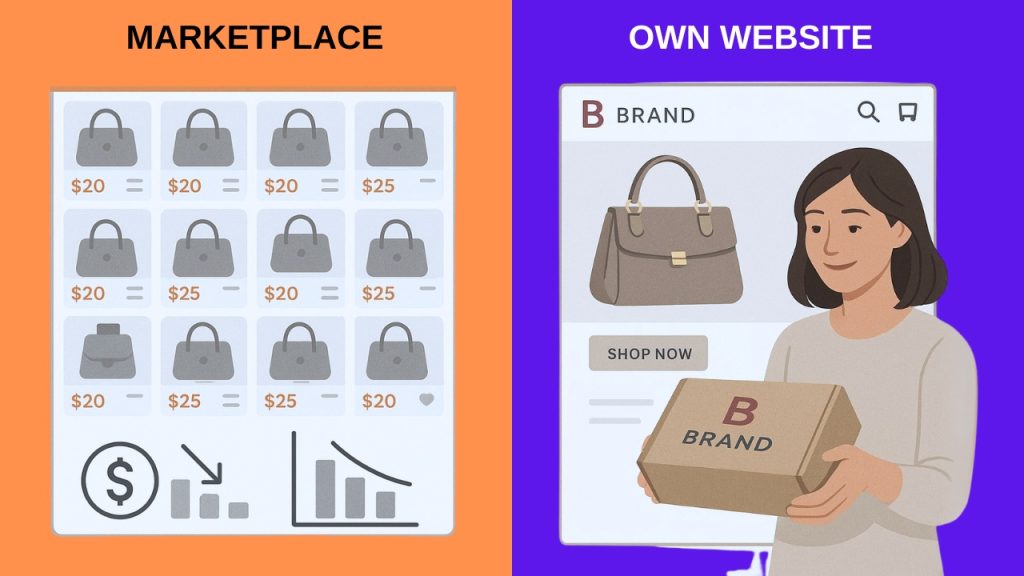In early 2024, Kim started selling her tote bags on Shopee Singapore.
Like many sellers, she appreciated the platform’s convenience and the continuous stream of customers at her fingertips.
But beneath that steady growth lurked a growing problem: hefty marketplace fees were quietly chipping away at her profits, while ever-changing rules made it harder to plan for the future.
Sound familiar? If you’re like Kim, selling on major marketplaces like Shopee or Lazada might feel like a double-edged sword. They offer access to customers, but you are at the mercy of their limits and fees.
So, is relying solely on these popular platforms enough? This is the question many first-time Singaporean e-commerce sellers wrestle with. Could shifting to your own website hold the key to better profits and independence?
The Shopee Seller’s Journey
A Quick Start
It’s no surprise that so many sellers start on marketplaces like Shopee. In Singapore, Shopee dominates the online shopping scene with a vast customer base, offering unmatched visibility that would otherwise cost a small business a fortune to access.
The platform’s straightforward setup and user-friendly tools mean you can get your products online and reach buyers almost immediately. This is a huge draw for entrepreneurs who want to hit the ground running without learning web design, payment systems, or digital marketing from scratch.
And let’s be honest: creating your own online store can feel daunting. Website setup, inventory management, payment integration: these are all walls that seem to require technical skills or specialist help. Marketplaces strip away those barriers, letting you focus on selling, not building.
But It Comes With Fees
While listing your products may be quick, Shopee has policies that may present challenges for sellers.
Firstly, the seller fees. As of March 2025, the base commissions for all sales is 7.63%. If you sell IT, electronics, gadgets and accessories, your fee is capped at SGD30. But if you sell anything else, there is no cap.
The only way to reduce this commission is to use Shopee as the fulfilment partner. This is known as “Fulfilled by Shopee” or FBS. If you send your goods to Shopee’s warehouse, and let them handle the logistics and delivery, your seller fees drop to 4.36%.
But on top of the commission fee, there is also the transaction fee of 3.27%.
So, for every sale, you would pay 7.63% + 3.27% (total 10.9%) of your revenue to Shopee for using the platform. This is not including any shipping fees.
For every sale, you could pay 10.9% of your revenue to Shopee
Once you add up all these fees, it could push your costs above 20% of your sales revenue. So, you have a tough decision: raise prices and risk losing shoppers, or accept thinner margins and hope volume makes up the difference.
And You Need to Play By The Platform Rules
It’s not just about how much you pay. Marketplaces come with strict rules that shape how your business runs. Naturally, they protect the buyer first.
Firstly, shipping windows are tight. Shopee, for example, enforces fixed periods in which orders must be shipped to maintain seller ratings. For someone handling inventory alone, or doing personalised packing, these deadlines can be stressful. Miss a deadline and your store risks penalties, reduced search rankings, or temporary sales restrictions.
If you want to be labelled as a preferred seller on Shopee, there are other KPIs too. These include a minimum response rate of 85% on all chat messages, at least 30 orders in 30 days, and a rating at least 4.6 stars.
Failing to hit targets for order fulfilment or customer service ratings often results in account downgrades, reduced visibility, or even suspension. These rules may change without warning, leaving sellers scrambling to adjust their processes.
Such unpredictability makes planning difficult. Marketing campaigns, stock management, or even holiday sales become a juggling act of meeting marketplace demands rather than focusing on your own growth.
You’re Not a Brand, You’re a Product
Arguably the biggest limitation is that you’re selling under their brand, not yours. When customers buy on Shopee, the marketplace brand is front and centre. Your store becomes just one among thousands under a generic banner.
This also means you don’t fully own your customer relationship. You are not allowed to contact customers outside of the Shopee chat, making it hard to build meaningful, personalised marketing strategies. So, encouraging repeat business outside the marketplace ecosystem is near impossible.
Some sellers get creative and sneak in flyers or name cards into their packages. This is against Shopee’s terms, and you could be suspended if you get caught.
And finally, your visibility depends heavily on Shopee’s algorithms. These complex ranking systems decide who sees your products and when, often favouring malls, preferred sellers or those willing to pay for promotions. This makes it hard for a new seller to build up their presence on Shopee. It can feel like you’re constantly chasing a moving target, with little control over traffic or sales growth.
How Your Own Website Solves These Issues

You Have Full Control Over Your Store and Operations
Owning your own website means running your business exactly how you want to. You get to set the rules, not the other way around.
For example, you decide your shipping policies and pricing strategies without arbitrary limits imposed by a marketplace. Want to offer free shipping above a certain order amount or try a tiered pricing model? It’s entirely up to you.
This freedom extends to promotions too. You can craft discounts, bundles, or flash sales tailored specifically for your audience, without an external platform dictating when or how you can run deals.
This control over marketing lets you respond quickly to trends, customer feedback, or seasonal demand. This is something that’s usually constrained on marketplaces.
But perhaps most importantly, having your own website puts your brand in front of your customers. Your customers shop directly with you, not under a generic marketplace umbrella. This usually means providing customer service over WhatsApp, which customers appreciate. This builds a cohesive experience, from browsing through to checkout, strengthening your brand identity and customer trust over time.
“My website customers have started to just tell me their repeat orders over WhatsApp, since they are so familiar with me now. It’s very good for loyalty”
Bee, a Shopee seller of eczema products who also has her own e-commerce website
Protecting Your Profits
One of the clearest advantages of your own e-commerce site is avoiding marketplace commissions. With no percentage cut siphoned off each sale, you keep a larger share of your revenue.
On top of that, you get to choose your payment methods, prioritising those with lower or even zero transaction fees. In Singapore, for example, PayNow offers an exceptionally affordable (often free) alternative to credit card payments.
These lower overheads improve your profit margins significantly, giving you financial breathing room. That means more potential to reinvest in your business, improve your products, or even pass savings onto customers through competitive pricing. The freedom to price strategically can be a powerful growth lever.
You Own Your Customer Data
Another hidden cost of marketplaces is losing access to your customer data. But with your own store, you collect and analyse this data directly. Every purchase, customer preference, and browsing behaviour is yours to use in crafting smarter marketing strategies.
This direct data access lets you engage customers beyond their first sale. You can create targeted email campaigns, personalised offers, or retargeting ads that bring shoppers back more often. No longer are you at the mercy of marketplace algorithms controlling who sees your products or when.
Ultimately, building your own customer database unlocks the potential for long-term loyalty. You’re not just selling a product; you’re nurturing a community around your brand. This is how sustainable businesses thrive over time.
Setting Up Your Own E-commerce Website
Building your own online store might sound intimidating, but it doesn’t have to be.
Many sellers choose to build their online stores using WooCommerce. It’s one of the most popular solutions – especially for small to medium-sized businesses in Singapore. Why? Because it’s free and open-source, so you keep your costs low. But don’t let the free price tag fool you; WooCommerce is used to power some of the biggest stores online.
One of the biggest advantages of WooCommerce is its widespread support. Because millions of users rely on it worldwide, you’ll find a wealth of tutorials, guides, and community forums just a quick search away. Whether you’re tech-savvy or a complete beginner, chances are someone else has faced the same questions and shared helpful answers.
Customisation is another strong selling point. You can tailor your site’s look and feel with thousands of WordPress themes, many of which are designed specifically for e-commerce. Plus, hundreds of plugins enable you to add features without needing to write a single line of code—from payment gateways to marketing tools and inventory management.
Key Features to Implement from the Start
When setting up your store, there are some essentials you want to get right from the start.
- Simple Product Listing and Inventory Management: Your website should make it easy to add new products and manage stock levels. WooCommerce provides intuitive interfaces to handle this smoothly, whether you sell one item or hundreds.
- Flexible Shipping Options Tailored to Your Needs: Unlike marketplaces that impose fixed shipping rules, your own store lets you define shipping methods, costs, and delivery areas. You might choose flat rates for local deliveries or integrate with courier services to calculate exact fees depending on customer location.
- Activate the Payment Options That You Want: You can still enable common payment options like credit cards. This is done via payment plugins that charge payment fees. But if you want to protect your profits, you should install a PayNow plugin as the primary payment method, and run it alongside the other payment options, mainly because it has little to no transaction fees for businesses. This means every dollar paid by your customers goes straight into your pocket, without deductions eating into your bottom line.
You can easily accept PayNow on your WooCommerce store using plugins like SGPayNowQR. This plugin generates dynamic QR codes for each order, allowing customers to scan and pay instantly via their bank apps, with no credit card fees or complicated setups.
This setup does more than just cut costs. It also streamlines the payment process, reducing friction that sometimes causes cart abandonment during checkout. With lower payment fees and a straightforward payment flow, you maximise the profit from each transaction while offering your customers a familiar and trusted payment option.
| Feature | Shopee (Marketplace) | Own Store (e.g., WooCommerce) |
|---|---|---|
| Traffic | Large existing customer base | Needs effort to build your own |
| Fees | High commission and transaction fees (e.g., ~10.9%). | Lower fees; PayNow can be 0% for businesses. |
| Control | Strict platform rules; limited customization. | Full control over rules, design, and operations. |
| Branding | Your brand is secondary to Shopee’s. | Full brand ownership |
| Customer Data | No direct access to customer data. | Full ownership and access to all customer data. |
| Marketing | Dependent on Shopee’s internal tools/algorithms. | Freedom to implement any marketing strategy. |
| Scalability | Tied to ad spend; limited by rules. | Highly scalable; can expand business models. |
| Start-up Time | Quick and easy initial setup. | More setup time but greater flexibility. |
Real Results and Impact
Bee is the owner of Skinshare.sg, a local online store selling curated skincare products for people with eczema. She also sells on Shopee, Lazada, Carousell and TikTok.
By selling products from her own store, she has developed a loyal following of regular customers. The website runs on WooCommerce, and she is able to run campaigns such as first-time customer discounts, cashback points, and gifts with purchase.
More importantly, she uses PayNow as the primary payment option, via the SGPayNowQR plugin. When a customer completes the checkout, a PayNow QR code is generated and shown to the customer, with the exact payment amount and order number already built in. And, she incurs zero payment fees to receive payments via this method.
As of today, nearly 40% of her customers choose to pay via PayNow using the plugin. That means, they are choosing PayNow over Visa, Master, GrabPay, as well as BNPL offerings like Atome. This has translated to nearly SGD1000 in additional savings annually.
And this is for a shop that is run by a solo founder. For a larger store, the savings could easily be in the thousands.
So, are you ready to take charge of your online business and keep more of the money you earn? Building your own e-commerce website is within your reach. But if you need help, let us know!





